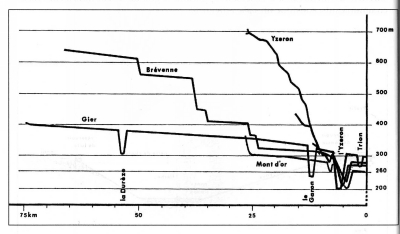

| 1. | source / infiltration galley |
| 2. | dropshafts |
| 3. | settling tank |
| 4. | tunnel and shafts (putei) |
| 5. | covered trench |
| 6. | aqueduct bridge |
| 7. | (inverted) siphon |
| 8. | substruction |
| 9. | arcade |
| 10. | distribution basin / castellum divisorium |
| 11. | water distribution (in this case with (lead) pipes into the town) |
Note the deep notches, respresenting the different siphons (La Durčze, Le Garon, L'Yzeron and the Trion) where the aqueducts made sharp bends down and up valleys.
Gradient
The gradient or fall of an aqueduct was an important factor. Too shallow a gradient and the water would not move, and to steep a gradient means the water would move too quickly. Typically, the slower the current the less need there would be for repairs, but the more time there would be for sediment in suspension to settle and clog the channel. A faster current would keep the channel cleaner, but would necessitate more repairs.The gradient was not uniform for an entire aqueduct - see the profile above - for a number of reasons. A tunnel might have a steeper gradient than average for the entire aqueduct, to keep it cleaner in view of the difficulties of cleaning it. A tunnel is also less likely to require repairs than a channel. A rapid increase in gradient might also serve to slow water down. The rate of flow increases, but the forward momentum does not increase. Like a waterfall, the turbulence at the end of the slope serves to slow the water down (Hodge, 2002).
The ancient sources give two quite different figures for a minimal acceptable slope, and these are not uncommonly at odds with the gradient of a number of aqueducts. Vitruvius suggests 0.5% and Pliny specifies 0.02%. The aqueducts themselves range between 0.3% and 0.15%, with extremes of 0.07% and 3.0% at Nīmes and Rome respectively.
From Evan J. Dembskey's thesis